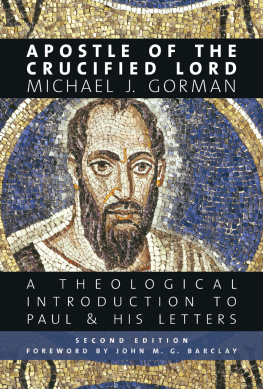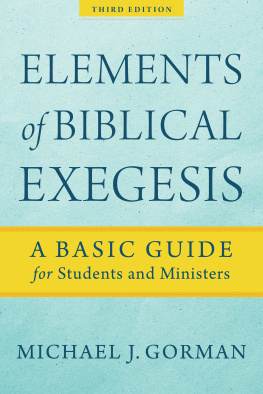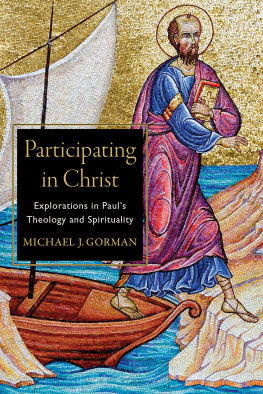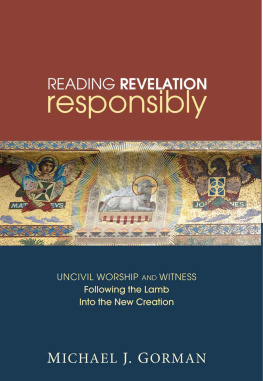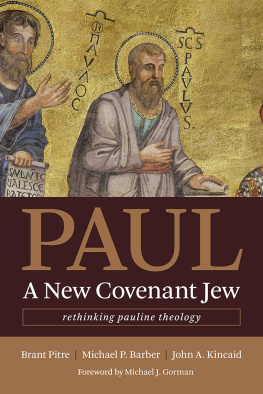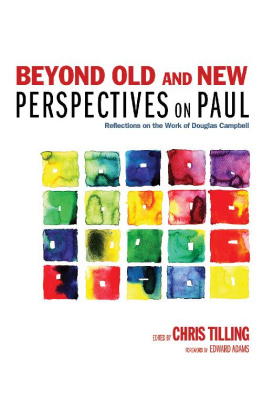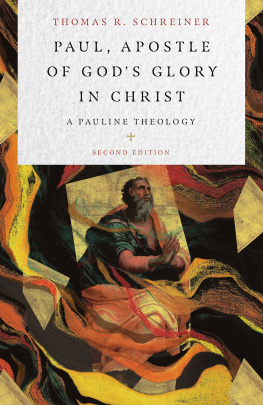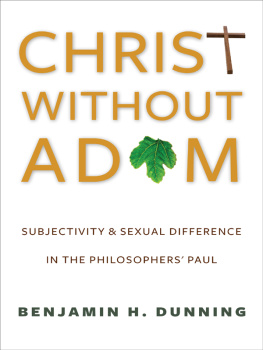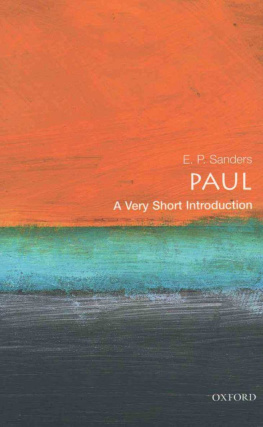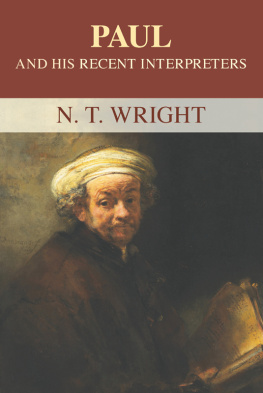I have used Michael Gormans introduction to Paul with both undergraduate and graduate students. In my experience it is the best available introduction to Paul and his letters. Theological as well as historical and literary in its approach, it introduces students to what they need to know about Paul and his letters. The appearance of this revised and updated edition is good news for all who love and teach Paul.
FRANK J. MATERA
Catholic University of America
In this accessible book written for a wide audience, Gorman charts a journey to the transformative heart of Pauls gospel: the crucified and resurrected Messiah.
SUSAN EASTMAN
Duke Divinity School
Apostle of the Crucified Lord
A THEOLOGICAL INTRODUCTION TO PAUL & HIS LETTERS
Second Edition
Michael J. Gorman
WILLIAM B. EERDMANS PUBLISHING COMPANY
GRAND RAPIDS, MICHIGAN
Wm. B. Eerdmans Publishing Co.
2140 Oak Industrial Drive N.E., Grand Rapids, Michigan 49505
www.eerdmans.com
2017 Michael J. Gorman
All rights reserved
Published 2017
22 21 20 19 18 17 1 2 3 4 5 6 7
ISBN 978-0-8028-7428-3
eISBN 978-1-4674-4694-5
Library of Congress Cataloging-in-Publication Data
Names: Gorman, Michael J., 1955 author.
Title: Apostle of the crucified Lord : a theological introduction to Paul & his letters / Michael J. Gorman.
Description: Second edition. | Grand Rapids, Michigan : William B. Eerdmans Publishing Company, 2017. | Includes bibliographical references and index.
Identifiers: LCCN 2016027073 | ISBN 9780802874283 (pbk. : alk. paper)
Subjects: LCSH: Bible. Epistles of PaulTheology.
Classification: LCC BS2651.G64 2017 | DDC 227/.06dc23
LC record available at https://lccn.loc.gov/2016027073
New Revised Standard Version Bible, copyright 1989, Division of Christian Education of the National Council of the Churches of Christ in the United States of America. Used by permission. All rights reserved.
For Richard Hays
mentor, colleague, friend
&
biblical scholar for the Church
Contents
Among the many books on Paul, Michael J. Gormans Apostle of the Crucified Lord occupies a special niche. Written out of three decades of experience as a teacher, the text and its layout are highly accessible to studentsclearly organised, well-illustrated, and reader-friendly. The treatment of Paul is also comprehensive (another text-book ideal): it covers all thirteen of the letters attributed to Paul, while explaining clearly the questions that surround authorship. But this is not just an ordinary introduction to Paul, as the subtitle with its adjective theological makes clear. While using all the resources of historical research and literary analysis, this book takes us to the subject matter of Pauls letters, the theology that governed these pastoral interventions into varied social contexts. One does not have to accept the canonical status of these letters to benefit from this theological focus, but those readers who do read Paul as Scripture will find this book particularly engaging. The question that throbs through this book, and is refracted in the probing questions at the end of each chapter, is this: if Paul expounded the good news of Jesus Christ in these ways in shaping first-century churches, what does it mean for us, now, in how we collectively express our participation in Gods cross-shaped mission to our world?
Not all scholars of Gormans stature would be willing to articulate that question. Some would regard it as mixing questions about the historical Paul with the contemporary concerns of the church, that is, the Paul of faith. But Gormans theological instincts are not just a product of his institutional location or of his primary intended readership. They also reflect a conviction that Pauls letters, written out of faith and for faith, demand a kind of existential engagement that cannot be complete if they are treated merely as relics of the past. And Gormans insistence that engagement should be corporate and social (in alter-cultural communities) is also peculiarly appropriate: Paul was not writing to individuals but to assemblies, and their theopolitical stance at an angle to their culture cannot be reduced to an individualistic piety. As Gorman puts it, faith for Paul is personal but not private, and it is that public dimension of the good news, which is now so widely discussed by both theological and non-theological readers of Paul (e.g., contemporary European philosophers), that comes powerfully to the fore in Gormans work.
This widely-used book is here issued in a welcome second edition, twelve years on from its first publication. The strong points of the original edition are wisely preserved: the judicious introduction to Pauls life and his theology; the careful reading of each of the thirteen letters, attending both to the story behind the text and to the story within it; the punchy questions at the end of each chapter, designed for individual reflection or group discussion. The annotated bibliographies have been helpfully updated and expanded, the discussion of Pauls theology has been reworked, and a welcome new introduction informs the reader of the multitude of perspectives on Paul, situating Gormans own position without the rancour that characterizes some Pauline scholarship.
Those familiar with scholarship on Paul will recognise the influence on this book of Morna Hooker, N. T. Wright, and (particularly) Richard Hays, to whom this second edition is dedicated. But Gorman has his own distinctive emphases in the ways he reads Paul, and these are all fruitfully provocative. Building on his own recent work, Gorman links the language of participation in Christ to the rich theology of thesis (deification) that springs from patristic theologians, inviting deep reflection on the ways in which the Christian life draws on the divine life of the resurrected Christ (see Rom 6). At the same time, Gorman rightly will not abandon the Lutheran emphasis on the crucified Lord (the cross as the signature of the risen Christ), and he helpfully draws out time and again (and supremely in the master narrative of Phil 2) how the cross shapes the life of Christian communities in suffering, service, and love. Finally, he draws out the socio-political significance of the benevolently subversive communities founded by Paul, and the contemporary questions they raise about (restorative) justice, reconciliation, and peace (non-violence).
Fundamental here is the clear-eyed perception that Pauls theology is not something simply to be believed. It is to be lived. As the Antioch incident shows, the moment of dispute between Paul and Peter (Gal 2:1121), the good news cannot rest as doctrine but is designed to be lived in socially innovative communities, which cross traditional barriers and challenge dominant systems of value. Peter and the others at Antioch did not walk in line with the truth of the good news (Gal 2:14), and for Paul it is not good news unless and until it is walked, that is, lived in practice. Gormans achievement in this book is not only to introduce Paul to a broad readership, but to point us in this direction of a lived, holistic faith, and to challenge believers to think out what it means to be followers of a crucified Lord in the critical and highly volatile context of the early twenty-first century.
June 2016
JOHN M. G. BARCLAY
Durham University
Much has happenedin Pauline studies, in theology, in the world, and in my own lifesince the publication of the first edition of this book in 2004. Happily, the book itself has been well received by professors, students, and other interested readers. A Korean translation appeared in 2014. I have been pleasantly surprised at the frequent references to the book in scholarly literature. I do, however, consider it a contribution to Pauline studies (especially this new edition), as well as a text.

